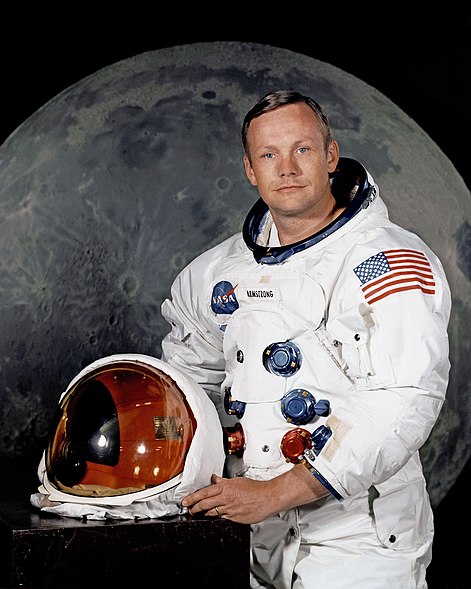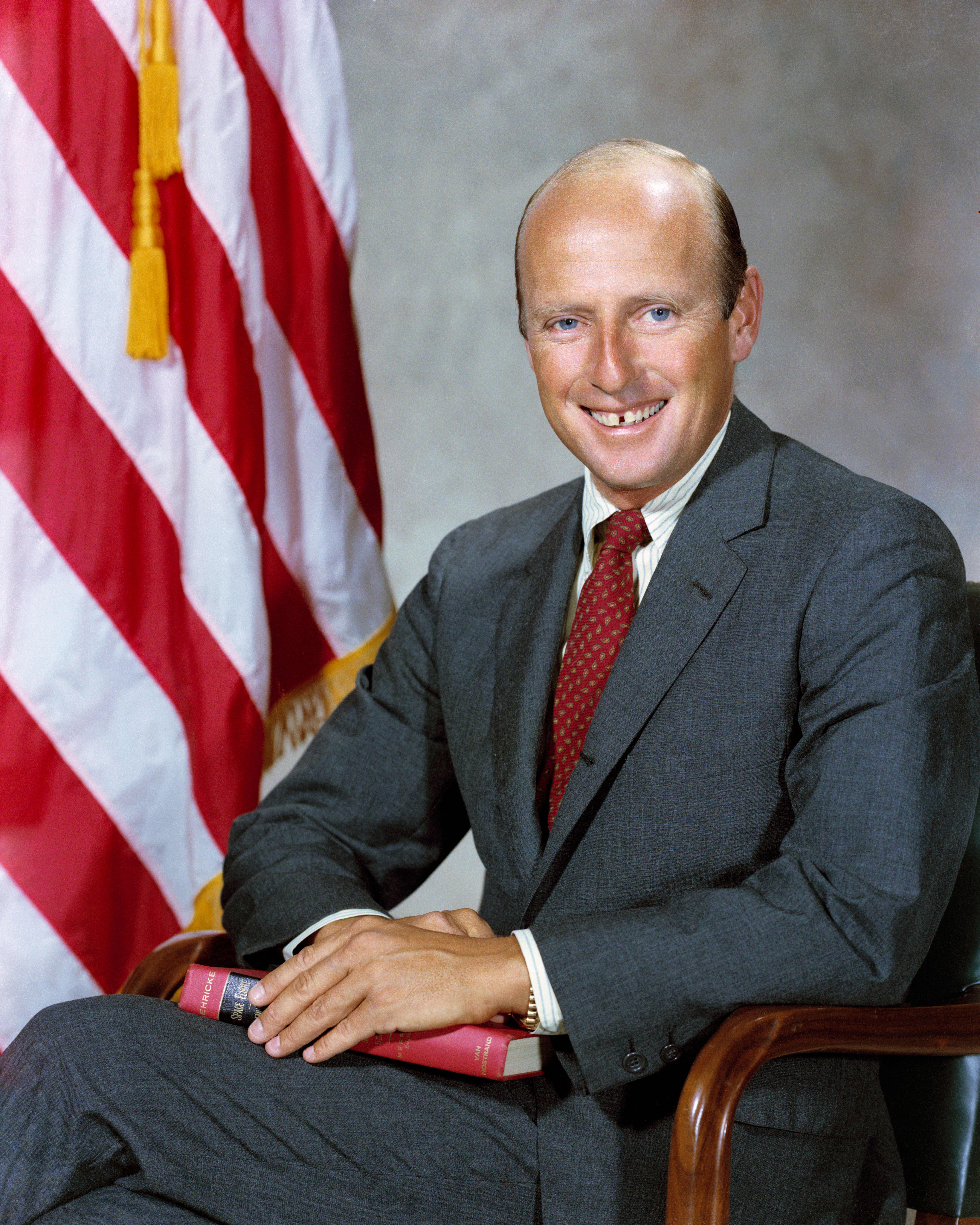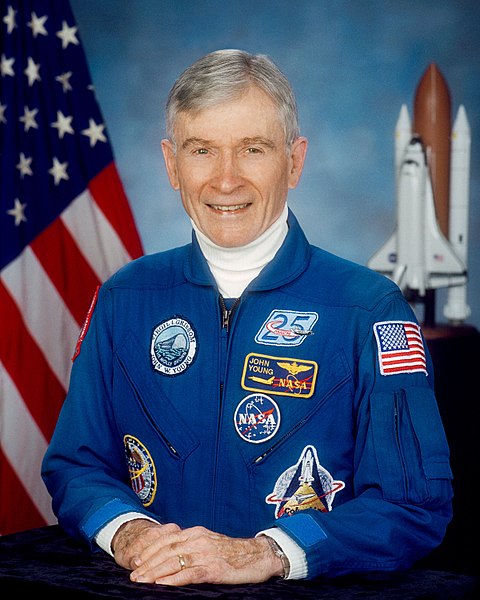1. Neil Armstrong (Apollo 11)
Neil Alden Armstrong (August 5, 1930 – August 25, 2012) was an American astronaut and the first person to walk on the Moon. He was also an aerospace engineer, naval aviator, test pilot, and university professor. Before becoming an astronaut, Armstrong was an officer in the U.S. Navy and served in the Korean War. After the war, he earned his bachelor's degree at Purdue University and served as a test pilot at the National Advisory Committee for Aeronautics High-Speed Flight Station, now known as the Dryden Flight Research Center, where he logged over 900 flights. He later completed graduate studies at the University of Southern California.
A participant in the U.S. Air Force's Man in Space Soonest and X-20 Dyna-Soar human spaceflight programs, Armstrong joined the NASA Astronaut Corps in 1962. He made his first space flight, as command pilot of Gemini 8, in 1966, becoming NASA's first civilian astronaut to fly in space. On this mission, he performed the first docking of two spacecraft, with pilot David Scott.
Armstrong's second and last spaceflight was as mission commander of the Apollo 11 moon landing, in July 1969. On this mission, Armstrong and Buzz Aldrin descended to the lunar surface and spent two and a half hours exploring, while Michael Collins remained in lunar orbit in the Command Module. Along with Collins and Aldrin, Armstrong was awarded the Presidential Medal of Freedom by President Richard Nixon; President Jimmy Carter presented Armstrong the Congressional Space Medal of Honor in 1978; he and his former crewmates received the Congressional Gold Medal in 2009.
Armstrong died in Cincinnati, Ohio, on August 25, 2012, at the age of 82, after complications from coronary artery bypass surgery.
2. Edwin "Buzz" Aldrin (Apollo 11)
Edwin Eugene "Buzz" Aldrin, Jr. (born January 20, 1930) is a former American astronaut, and the second person to walk on the Moon. He was the lunar module pilot on Apollo 11, the first manned lunar landing in history. He set foot on the Moon at 03:15:16 (UTC) on July 21, 1969, following mission commander Neil Armstrong. He is also a retired United States Air Force pilot.
3. Pete Conrad (Apollo 12)
Charles "Pete" Conrad, Jr. (June 2, 1930 – July 8, 1999) was a U.S. Navy officer and NASA astronaut, and during the Apollo 12 mission became the third man to walk on the Moon. He set an eight-day space endurance record along with his command pilot Gordon Cooper on the Gemini 5 mission, and commanded the Gemini 11 mission. After Apollo, he commanded the Skylab 2 mission (the first manned one), on which he and his crewmates repaired significant launch damage to the Skylab space station. For this, President Jimmy Carter awarded him the Congressional Space Medal of Honor in 1978.
4. Alan Bean (Apollo 12)
Alan LaVern Bean (born March 15, 1932) is a former NASA astronaut and currently a painter. Bean was selected to become an astronaut by NASA in 1963 as part of Astronaut Group 3. He made his first flight into space aboard Apollo 12, the second manned mission to land on the Moon, at the age of thirty-seven years in November 1969. During this mission, Bean became the fourth person to walk on the Moon. He made his second and final flight into space on the Skylab 3 mission in 1973, the second manned mission to the Skylab space station. After retiring from the United States Navy
in 1975 and NASA in 1981, Bean pursued his interest in painting,
depicting various space-related scenes and documenting his own
experiences in space as well as that of his fellow Apollo Program astronauts.
5. Alan Shepard (Apollo 14)
Alan Bartlett "Al" Shepard, Jr. (November 18, 1923 – July 21, 1998) was an American naval aviator, test pilot, flag officer, NASA astronaut, and businessman, who in 1961 became the second person, and the first American, to travel into space. This Mercury
flight was designed to enter space, but not to achieve orbit. Ten years
later, at age 47 the oldest astronaut in the program, Shepard commanded
the Apollo 14 mission, piloting the lander to the most accurate landing of the Apollo missions. He became the fifth person to walk on the Moon, and the only astronaut of the Mercury Seven to walk on the Moon. During the mission, he hit two golf balls on the lunar surface.
These were his only two space flights, as his flight status was interrupted for five years (1964–69) during the Mercury and Gemini programs by Ménière's disease, an inner-ear disease that was surgically corrected before his Moon flight. Shepard served as Chief of the Astronaut Office
from November 1963 – July 1969 (approximately the period of his
grounding), and from June 1971 – August 1, 1974, (from his last flight,
to his retirement). He was promoted from Captain to Rear Admiral on August 25, 1971.He retired from the United States Navy and NASA in 1974.After leaving NASA, he became a successful businessman. He died of leukemia in 1998, five weeks before the death of his wife of 53 years. They were survived by their three daughters.
6. Edgar Mitchell (Apollo 14)
Edgar Dean "Ed" Mitchell, Sc.D. (born September 17, 1930) is an American pilot, retired Captain in the United States Navy and NASA astronaut. As the lunar module pilot of Apollo 14, he spent nine hours working on the lunar surface in the Fra Mauro Highlands region, making him the sixth person to walk on the Moon.
7. David Scott (Apollo 15)
David Randolph "Dave" Scott (born June 6, 1932) is an American engineer, retired U.S. Air Force officer, former test pilot, and former NASA astronaut. He belonged to the third group of NASA astronauts, selected in October 1963. As an astronaut, Scott became the seventh person to walk on the Moon.
Before becoming an astronaut, Scott graduated from the United States Military Academy at West Point and joined the United States Air Force. Scott retired from the Air Force in 1975 with the rank of colonel, and more than 5,600 hours of logged flying time.As an astronaut, Scott made his first flight into space as pilot of the Gemini 8 mission, along with Neil Armstrong, in March 1966, spending just under eleven hours in Low Earth orbit. Scott then spent ten days in orbit as Command Module Pilot aboard Apollo 9, his second spaceflight, along with Commander James McDivitt and Lunar Module Pilot Rusty Schweickart. During this mission, Scott became the last American to fly solo in Earth orbit (not counting subsequent untethered EVAs). Scott made his third and final flight into space as commander of the Apollo 15 mission, the fourth human lunar landing, becoming the seventh person to walk on the Moon and the first person to drive on the Moon.
8. James Irwin (Apollo 15)
James Benson "Jim" Irwin (March 17, 1930 – August 8, 1991) was an American astronaut. He served as Lunar Module pilot for Apollo 15, the fourth human lunar landing. He was the eighth person to walk on the Moon and the first, and youngest, of those astronauts to die
9. John Young (Apollo 16)
Young enjoyed the longest career of any astronaut, becoming the first person to make six space flights over the course of 42 years of active NASA service, and is the only person to have piloted four different classes of spacecraft: Gemini, the Apollo Command/Service Module, the Apollo Lunar Module, and the Space Shuttle.
In 1965, Young flew on the first manned Gemini mission, and in 1969 was the first person to orbit the moon alone during Apollo 10. He is one of only three persons to have twice journeyed to the Moon, and drove the Lunar Roving Vehicle on the Moon's surface. He also commanded two Space Shuttle flights, including its first launch in 1981, and served as Chief of the Astronaut Office from 1974–1987. Young retired from NASA in 2004.
10. Charlie Duke (Apollo 16)
A former test pilot, Duke has logged 4,147 hours flying time, which includes 3,632 hours in jet aircraft; and 265 hours in space, plus 21 hours and 28 minutes of extra-vehicular activity.
A resident of New Braunfels, Texas, he is currently chairman of the board of directors of the Astronaut Scholarship Foundation










No comments:
Post a Comment